Can a function be both even and odd? Give reasons for your answer.
Table of contents
- 0. Functions7h 54m
- Introduction to Functions16m
- Piecewise Functions10m
- Properties of Functions9m
- Common Functions1h 8m
- Transformations5m
- Combining Functions27m
- Exponent rules32m
- Exponential Functions28m
- Logarithmic Functions24m
- Properties of Logarithms36m
- Exponential & Logarithmic Equations35m
- Introduction to Trigonometric Functions38m
- Graphs of Trigonometric Functions44m
- Trigonometric Identities47m
- Inverse Trigonometric Functions48m
- 1. Limits and Continuity2h 2m
- 2. Intro to Derivatives1h 33m
- 3. Techniques of Differentiation3h 18m
- 4. Applications of Derivatives2h 38m
- 5. Graphical Applications of Derivatives6h 2m
- 6. Derivatives of Inverse, Exponential, & Logarithmic Functions2h 37m
- 7. Antiderivatives & Indefinite Integrals1h 26m
- 8. Definite Integrals4h 44m
- 9. Graphical Applications of Integrals2h 27m
- 10. Physics Applications of Integrals 3h 16m
- 11. Integrals of Inverse, Exponential, & Logarithmic Functions2h 31m
- 12. Techniques of Integration7h 41m
- 13. Intro to Differential Equations2h 55m
- 14. Sequences & Series5h 36m
- 15. Power Series2h 19m
- 16. Parametric Equations & Polar Coordinates7h 58m
0. Functions
Common Functions
Problem 1.1.76b
Textbook Question
Industrial costs A power plant sits next to a river where the river is 800 ft wide. Laying a new cable from the plant to a location in the city 2 mi downstream on the opposite side costs \$180 per foot across the river and \$100 per foot along the land.
<IMAGE>
b. Generate a table of values to determine whether the least expensive location for point Q is less than 2000 ft or greater than 2000 ft from point P.
 Verified step by step guidance
Verified step by step guidance1
Convert all measurements to the same unit. Since the river is 800 ft wide and the city is 2 miles downstream, convert 2 miles to feet. (1 mile = 5280 feet, so 2 miles = 10560 feet).
Define the variables: Let x be the distance from the power plant to point Q along the riverbank. The remaining distance along the riverbank to the city is then (10560 - x) feet.
Calculate the cost of laying the cable across the river. The cost is \$180 per foot, so the cost across the river is 180 * 800.
Calculate the cost of laying the cable along the land. The cost is \$100 per foot, so the cost along the land is 100 * (10560 - x).
Create a table of values for different values of x (e.g., 1000, 1500, 2000, 2500, 3000) and calculate the total cost for each value by adding the cost across the river and the cost along the land. Compare these costs to determine if the least expensive location for point Q is less than or greater than 2000 ft from point P.
 Verified video answer for a similar problem:
Verified video answer for a similar problem:This video solution was recommended by our tutors as helpful for the problem above
Video duration:
7mPlay a video:
Was this helpful?
Key Concepts
Here are the essential concepts you must grasp in order to answer the question correctly.
Optimization
Optimization in calculus involves finding the maximum or minimum values of a function. In this context, it is essential to determine the least expensive way to lay the cable, which requires setting up a cost function based on the distances involved and then using techniques such as derivatives to find the minimum cost.
Recommended video:

Intro to Applied Optimization: Maximizing Area
Distance Calculation
Distance calculation is crucial for determining the lengths of cable needed for both the river crossing and the land route. The total distance can be expressed as a function of the variable distance from point P to point Q, which will help in formulating the cost function that needs to be minimized.
Recommended video:

Estimating the Area Under a Curve Using Left Endpoints
Cost Function
A cost function represents the total cost associated with a particular decision or scenario. In this problem, the cost function will combine the costs of laying cable across the river and along the land, allowing for the analysis of different scenarios to find the least expensive option for the cable layout.
Recommended video:

Properties of Functions

 5:57m
5:57mWatch next
Master Graphs of Common Functions with a bite sized video explanation from Patrick
Start learningRelated Videos
Related Practice
Textbook Question
